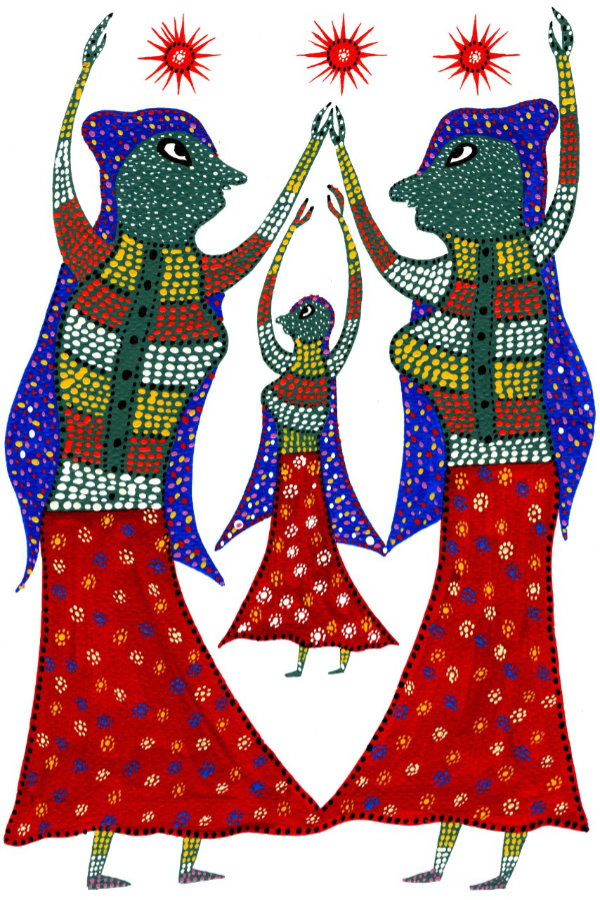Entry Fees : Rs. 20/- per Indian Visitor.
Rs. 400/- per Foreigner.
Camera Charges - Rs 100/- per Camera

The dance formations of the tribes are inspired by living beings and the flora and fauna. Dance postures are created by Slow movement of trees due to gusts of wind or behavior of creatures. Their dances are not linear but are combined in a circular form and motion. The earth is round, this is at its core. They are in harmony with nature even though they are involved in dance. Often it can also be assumed that according to the kind of environment in which a community lives, the accompaniment of its instruments is also seen in its dances. One of the purposes of the musical instruments in dances has also been to inform far and wide about the auspiciousness of the festival. If a community resides in a very dense forest area, such instruments will be used in the dance, which serve Its purpose. Similarly, the central presence of strings and wind instruments is found in the musical instruments of the communities who live in hilly and plain areas.
The same situation is found in the clothes, jewelry and other adornments during the dance as well. The use of feathers on the head, shell on the body and leather on the instrument is to hold the sky. Pataal (the world under the water) and Earth together and celebrate with them, respectively. Tribal dance festival is being done with these totalities
There is not much variety in the postures of tribal dances. They dance whole night in limited dance postures and body movements while in comparison to the tribal communities folk communities have more dance forms and posturos. This explains the patience of these communities and their serene lifestyle.
There are no spectators in tribal dances, there everyone participates while folk dances have a certain audience, which does not participate actively in it. The variety in dance postures and body movements are for the viewer. It is also that folk dances are occasion specific and are associated with the season, Farming or festivals whereas this is not the case with tribal dances.
जनजातियों की नृत्य संरचनाएं पेड़ पौधों और जीव-जन्तुओं से प्रेरित होती हैं। हवा के झोंकों से वृक्षों का मन्द मन्द हिलना या पशु-पक्षियों के व्यवहार से नृत्य मुद्राओं का निर्माण होता है। इनके नृत्य रैखिक न होकर वृत्ताकार रूप में संयोजित होते हैं। इसके मूल में धरती का वृत्त में होना है। वे नृत्य में होकर भी प्रकृति को अनुकूलता में ही होते हैं। प्रायः यह भी लखित किया जा सकता है कि जो समुदाय जिस तरह के परिवेश में रहता है, उसके अनुसार ही उसके बाद की संगति भी नृत्य में देखने को मिलती है। नृत्यों में वायों की उपयोगिता का एक उद्देश्य दूर तक अपने उत्सव की मांगलिकता की सूचना देना भी होता है। यदि समुदाय का बहुत सघन वन क्षेत्र में निवास है तो ऐसे धन वाय उसकी नृत्य संगति में होंगे जो उसके उद्देश्य को पूरा करते हो। इसी प्रकार पहाड़ी और मैदानी क्षेत्रों में निवास करने वाले समुदायों के वायाँ में तार एवं फूँक वायों को केन्द्रीय संगति पाई जाती है।
यही स्थिति नृत्य के दौरान वस्त्र, आभूषण और अन्य अलंकरणों में भी है। सिर पर पंख, देह पर कौड़ी और बाद में धर्म का उपयोग क्रमशः आकाश, पाताल (जल में पाये जाने के कारण) और धरती को एक साथ धारण करने और उसके साथ उत्सव मनाने के संदर्भ में है। जनजातीय नृत्योत्सव इन समग्रताओं के साथ किया जा रहा है।
जनजातीय नृत्यों की मुद्राओं में बहुत विविधता नहीं होती। सीमित नृत्य मुद्राओं, गतियों में पूरी रात नृत्य किया जाता है। लोक समुदायों की नृत्य मुद्राओं में जनजातीय समुदायों की तुलना में अधिकता है। इससे इन समुदायों को धीरता और उनके पैवपूर्ण जीवनशैली को समझा जा सकता है। जनजातीय नृत्यों में दर्शक नहीं है, वहाँ सभी उसके अंग हैं। पूरा गाँव नृत्य में पारी पारी अपनी हिस्सेदारी करता है। परन्तु लोकनृत्यों में एक दर्शक समुदाय भी होता है जो उसमें हिस्सेदारी नहीं करता। नृत्य मुद्राओं में विविधता और आगिक धाएँ दर्शक के लिये होती है। यह भी कि लोक नृत्य अनुकूल होते हैं। ऋतु परिवर्तन स्वेती-किसानी या पर्व-स्वरों से लोक नृत्यों को सम्बद्धता है। ऐसा जनजातीय नृत् साथ पूरी तरह से नहीं है।
संतोष, गुलजार, सुकल, कृष्णपाल, रविन्द्र, महेन्द्र- (नीम का पेड़ )